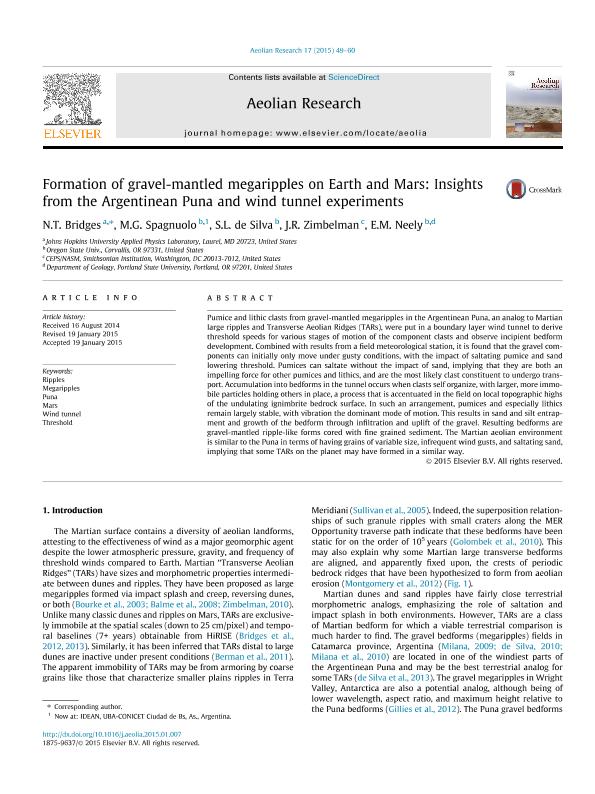Artículo
Formation of gravel-mantled megaripples on Earth and Mars: Insights from the Argentinean Puna and wind tunnel experiments
Fecha de publicación:
06/2015
Editorial:
Elsevier Science
Revista:
Aeolian Research
ISSN:
1875-9637
Idioma:
Inglés
Tipo de recurso:
Artículo publicado
Clasificación temática:
Resumen
Pumice and lithic clasts from gravel-mantled megaripples in the Argentinean Puna, an analog to Martian large ripples and Transverse Aeolian Ridges (TARs), were put in a boundary layer wind tunnel to derive threshold speeds for various stages of motion of the component clasts and observe incipient bedform development. Combined with results from a field meteorological station, it is found that the gravel components can initially only move under gusty conditions, with the impact of saltating pumice and sand lowering threshold. Pumices can saltate without the impact of sand, implying that they are both an impelling force for other pumices and lithics, and are the most likely clast constituent to undergo transport. Accumulation into bedforms in the tunnel occurs when clasts self organize, with larger, more immobile particles holding others in place, a process that is accentuated in the field on local topographic highs of the undulating ignimbrite bedrock surface. In such an arrangement, pumices and especially lithics remain largely stable, with vibration the dominant mode of motion. This results in sand and silt entrapment and growth of the bedform through infiltration and uplift of the gravel. Resulting bedforms are gravel-mantled ripple-like forms cored with fine grained sediment. The Martian aeolian environment is similar to the Puna in terms of having grains of variable size, infrequent wind gusts, and saltating sand, implying that some TARs on the planet may have formed in a similar way.
Palabras clave:
Ripples
,
Puna
,
Mars
,
Wind Tunnel
Archivos asociados
Licencia
Identificadores
Colecciones
Articulos(IDEAN)
Articulos de INSTITUTO DE ESTUDIOS ANDINOS "DON PABLO GROEBER"
Articulos de INSTITUTO DE ESTUDIOS ANDINOS "DON PABLO GROEBER"
Citación
Bridges, N. T.; Spagnuolo, Mauro Gabriel; de Silva, S. L.; Zimbelman, J. R.; Neely, E. M.; Formation of gravel-mantled megaripples on Earth and Mars: Insights from the Argentinean Puna and wind tunnel experiments; Elsevier Science; Aeolian Research; 17; 6-2015; 49-60
Compartir
Altmétricas




